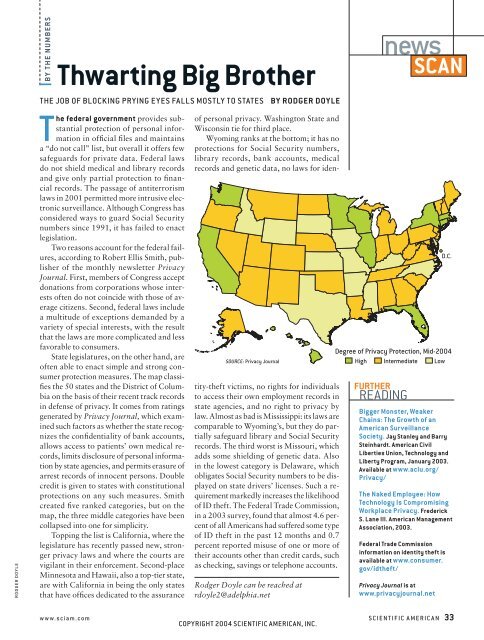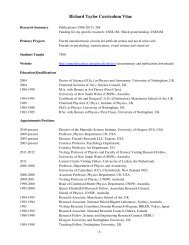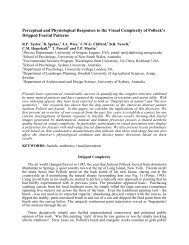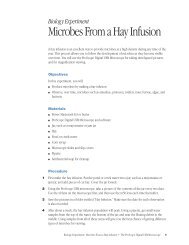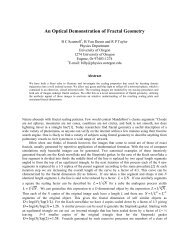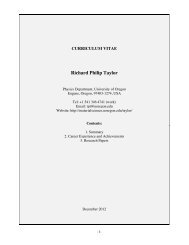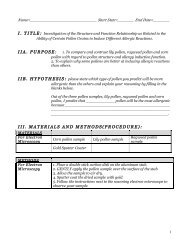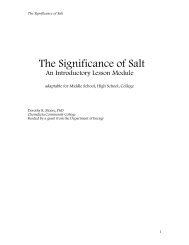December 2004 - Materials Science Institute - University of Oregon
December 2004 - Materials Science Institute - University of Oregon
December 2004 - Materials Science Institute - University of Oregon
Create successful ePaper yourself
Turn your PDF publications into a flip-book with our unique Google optimized e-Paper software.
RODGER DOYLE<br />
BY THE NUMBERS<br />
Thwarting Big Brother<br />
THE JOB OF BLOCKING PRYING EYES FALLS MOSTLY TO STATES BY RODGER DOYLE<br />
The federal government provides substantial<br />
protection <strong>of</strong> personal information<br />
in <strong>of</strong>fi cial fi les and maintains<br />
a “do not call” list, but overall it <strong>of</strong>fers few<br />
safeguards for private data. Federal laws<br />
do not shield medical and library records<br />
and give only partial protection to fi nancial<br />
records. The passage <strong>of</strong> antiterrorism<br />
laws in 2001 permitted more intrusive electronic<br />
surveillance. Although Congress has<br />
considered ways to guard Social Security<br />
numbers since 1991, it has failed to enact<br />
legislation.<br />
Two reasons account for the federal failures,<br />
according to Robert Ellis Smith, publisher<br />
<strong>of</strong> the monthly newsletter Privacy<br />
Journal. First, members <strong>of</strong> Congress accept<br />
donations from corporations whose interests<br />
<strong>of</strong>ten do not coincide with those <strong>of</strong> average<br />
citizens. Second, federal laws include<br />
a multitude <strong>of</strong> exceptions demanded by a<br />
variety <strong>of</strong> special interests, with the result<br />
that the laws are more complicated and less<br />
favorable to consumers.<br />
State legislatures, on the other hand, are<br />
<strong>of</strong>ten able to enact simple and strong consumer<br />
protection measures. The map classifi<br />
es the 50 states and the District <strong>of</strong> Columbia<br />
on the basis <strong>of</strong> their recent track records<br />
in defense <strong>of</strong> privacy. It comes from ratings<br />
generated by Privacy Journal, which examined<br />
such factors as whether the state recognizes<br />
the confi dentiality <strong>of</strong> bank accounts,<br />
allows access to patients’ own medical records,<br />
limits disclosure <strong>of</strong> personal information<br />
by state agencies, and permits erasure <strong>of</strong><br />
arrest records <strong>of</strong> innocent persons. Double<br />
credit is given to states with constitutional<br />
protections on any such measures. Smith<br />
created fi ve ranked categories, but on the<br />
map, the three middle categories have been<br />
collapsed into one for simplicity.<br />
Topping the list is California, where the<br />
legislature has recently passed new, stronger<br />
privacy laws and where the courts are<br />
vigilant in their enforcement. Second-place<br />
Minnesota and Hawaii, also a top-tier state,<br />
are with California in being the only states<br />
that have <strong>of</strong>fi ces dedicated to the assurance<br />
<strong>of</strong> personal privacy. Washington State and<br />
Wisconsin tie for third place.<br />
Wyoming ranks at the bottom; it has no<br />
protections for Social Security numbers,<br />
library records, bank accounts, medical<br />
records and genetic data, no laws for iden-<br />
tity-theft victims, no rights for individuals<br />
to access their own employment records in<br />
state agencies, and no right to privacy by<br />
law. Almost as bad is Mississippi: its laws are<br />
comparable to Wyoming’s, but they do partially<br />
safeguard library and Social Security<br />
records. The third worst is Missouri, which<br />
adds some shielding <strong>of</strong> genetic data. Also<br />
in the lowest category is Delaware, which<br />
obligates Social Security numbers to be displayed<br />
on state drivers’ licenses. Such a requirement<br />
markedly increases the likelihood<br />
<strong>of</strong> ID theft. The Federal Trade Commission,<br />
in a 2003 survey, found that almost 4.6 percent<br />
<strong>of</strong> all Americans had suffered some type<br />
<strong>of</strong> ID theft in the past 12 months and 0.7<br />
percent reported misuse <strong>of</strong> one or more <strong>of</strong><br />
their accounts other than credit cards, such<br />
as checking, savings or telephone accounts.<br />
Rodger Doyle can be reached at<br />
rdoyle2@adelphia.net<br />
news<br />
SCAN<br />
<br />
<br />
FURTHER<br />
READING<br />
Bigger Monster, Weaker<br />
Chains: The Growth <strong>of</strong> an<br />
American Surveillance<br />
Society. Jay Stanley and Barry<br />
Steinhardt. American Civil<br />
Liberties Union, Technology and<br />
Liberty Program, January 2003.<br />
Available at www.aclu.org/<br />
Privacy/<br />
The Naked Employee: How<br />
Technology Is Compromising<br />
Workplace Privacy. Frederick<br />
S. Lane III. American Management<br />
Association, 2003.<br />
Federal Trade Commission<br />
information on identity theft is<br />
available at www.consumer.<br />
gov/idtheft/<br />
Privacy Journal is at<br />
www.privacyjournal.net<br />
www.sciam.com SCIENTIFIC AMERICAN 33<br />
COPYRIGHT <strong>2004</strong> SCIENTIFIC AMERICAN, INC.


